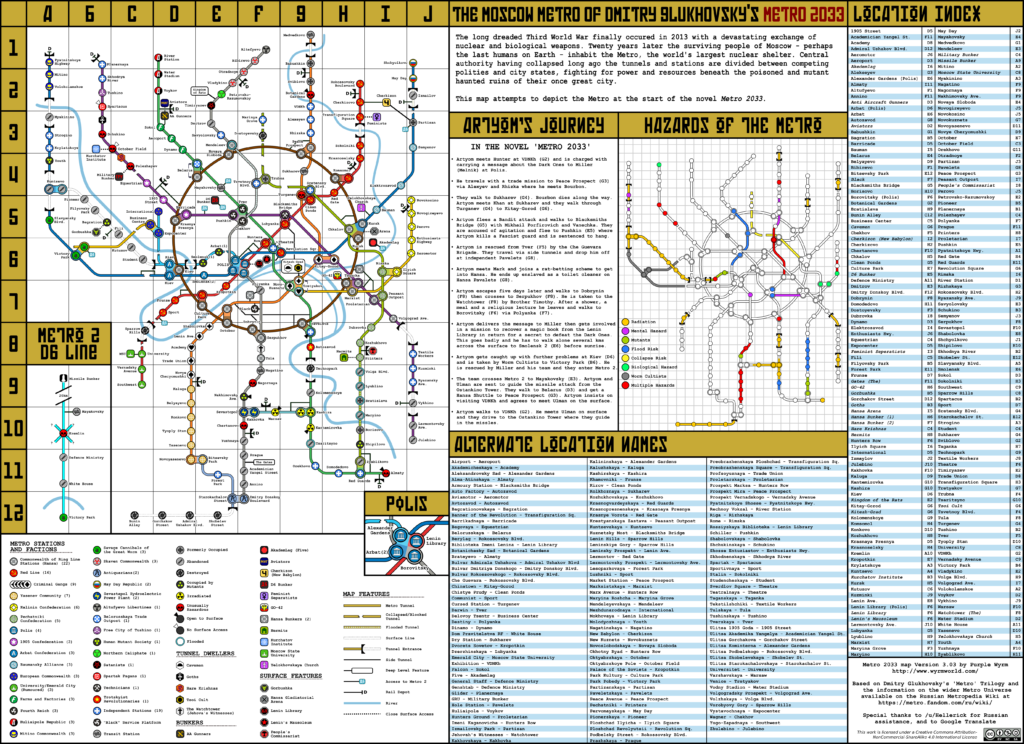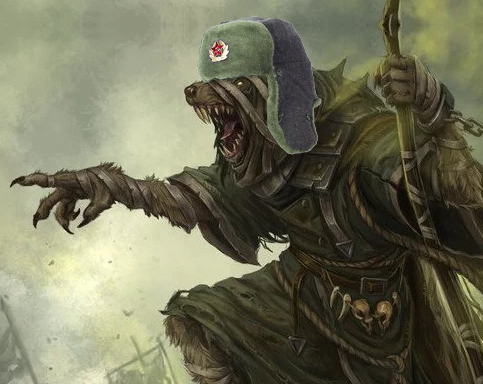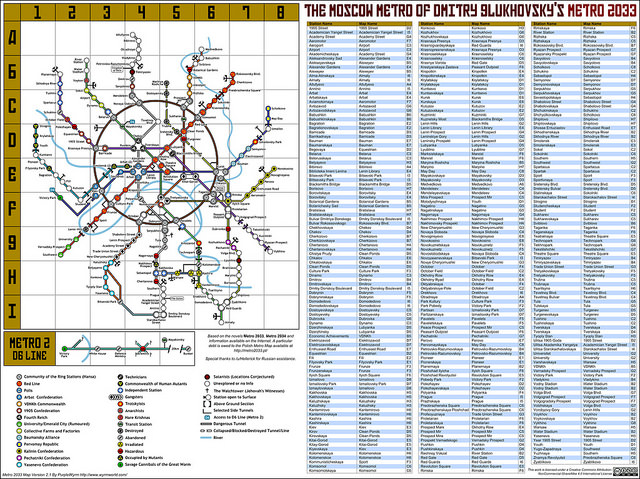I finished another of my Christmas books, the Russian sci-fi novel Metro 2033 by Dmitry Glukhovsky yesterday. For those not in the know – as I was not until Helen mentioned it in an email a few months back – it’s a post-apocalyptic story set among survivors of world war three inhabiting a rebuilt society (of sorts) in the Moscow Metro system.
The setting is fascinating. Each station (the inhabited ones anyway) is its own town with its own government, customs and specialities. Some stations have banded together to form wider alliances, such as the Hansa who regulate trade throughout the system via control of the Circle line, the Communists who have taken almost complete control of the Sokolnicheskaya line, the neo-nazi skinhead Fascists who control a major interchange, and the mysterious Polis beneath the heart of the dead city whose inhabitants are said to live almost as well as people did before the war. Bandits, mutants, gas pockets, seeping radiation and worse things make travel between stations difficult – traveling from one end of the system to the other can take weeks, in contrast to the couple of hours it took back in the days when the trains ran. The surface is uninhabitable, plagued by dangerous creatures and lingering radiation that makes going outside without protective gear a death sentence. And even with a gasmask and environment suit the surface can only be braved at night – after decades underground the survivors’ vision has become so sensitive that the sun would instantly blind them.
As is traditional for such settings the story is that of a quest. The main character, Artyom, must leave his home station of VDNKh – under seige by terrifying mutants from the surface known as ‘Dark Ones’ – and deliver a message to Polis in the hopes of saving not only his home, but the entire Metro. We follow him on his dangerous journey and get to see the Metro and its inhabitants through his eyes. It’s a damn good adventure story, so good in fact that it’s sold over 500,000 copies in Russia alone and spawned a franchise with a sequel, stories by other authors, and two computer games.
That’s the good stuff. The other stuff, well…
The prose is not great. With a few exceptions it’s slow, pedestrian and stilted. Dialogue between characters is awkward and in some places so forced that you could envisage it being read off an autocue. A random example…
He spoke totally without accent, his pronunciation was no different than Artyom’s or Sukhoi’s. That was very strange – hearing pure Russian speech from such an unusual being. Artyom couldn’t shed the feeling that this was some kind of farce and the narrow-eyed man was only moving his lips while the bearded guy or the man in the leather coat spoke from behind him.
‘I shot one of their officers,’ he admitted reluctantly.
‘Well, good for you! You’re just the kind we like! That’s what they deserve!’ the man with the high cheek bones said enthusiastically, and the big, dark skinned guy who was sitting at the front turned to Artyom and raised his eyebrows respectfully. Artyom thought that this guy must mispronounce words.
See what I mean?
Given the book’s great popularity in its native country I suspect that this is all down to a quick, by-the-numbers translation by someone familiar with English on an academic or business level but with limited exposure to the language in a literary or informal setting. Which is a real shame as the story deserves much better.
In addition to being dull and stilted the translation has other issues. The different stations are highly important to the plot, but their names are mostly left untranslated. This makes it hard to get your head around the Metro as every location is a random string of syllables, completely bereft of meaning. Coming up with an English name for each station would have gone a long way towards both mentally navigating the Metro and creating atmosphere. ‘Sparrow Hills’ for Vorobyovy Gory, ‘Clear Ponds’ for Chistye Prudy, ‘Mir Avenue’ for Prospekt Mir. At the very least ‘skaya’ could have been cut off the end of the names and either rendered as ‘Station’ or left off entirely. Alekseyev and Oktyabr are easier to get to grips with than Alekseyevstraya and Oktyabrstraya for instance.
And while we’re on the subject of station names, the map provided in the book is horrible. A bunch of stations important to the plot aren’t even labeled! Try and find Sukharevskaya on it, I dare you! I had to resort to looking a map up on Wikipedia to figure out what the hell was going on half the time. In addition to not including vital information for understanding the text, it does include information that really should be left to the reader to discover by actually reading the text. For the sake of avoiding spoilers I won’t elaborate, but it would have added a real sense of exploration to the story if the map started out limited to just what Artyom knows and you have to fill it out mentally along with him as the plot progresses.
Oh, and ‘Artyom’. Couldn’t that have been rendered as ‘Artie’ in non-formal instances?
While reading the story I was often pulled out of the action by thinking about how I’d rewrite certain passages. In fact, I think I’ll have a go with the example from above…
He spoke without an accent, his pronunciation was no different to that of Artie’s or Uncle Sukhoi’s. It was strange, hearing pure, unadulterated Russian from such an unusual looking individual. Artie couldn’t shake the feeling that his rescuers were playing some kind of joke, and that the narrow-eyed man was moving his lips while the bearded man or the guy in the leather coat spoke instead.
‘I shot one of their officers,’ he admitted reluctantly.
‘Good for you!’ enthused the man with the high cheek bones. “That’s what they deserve. You’re the kind of guy we like!”. The big, dark skinned man at the front of the cart turned and raised his eyebrows in respect. ‘Surely’ thought Artie ‘This guy can’t speak proper Russian?’.
Now I’m not saying it’s Shakespeare, but I like to think it’s better than the 0fficial version.
Anyway, translation issues aside it’s a great book and well worth a read if you’re into post apocalyptic fiction. Check it out, and be sure to come back regularly for my chapter by chapter unauthorised re-translation!
(Just kidding 🙂 )




